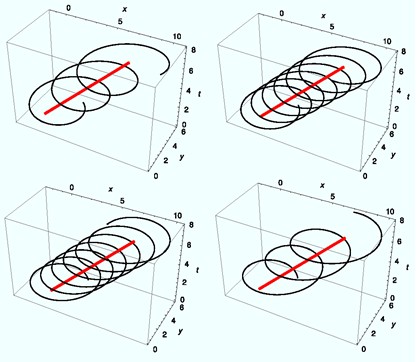Researchers in the Institute of Modern Physics, Chinese Academy of Sciences (IMP), with their collaborators from Cambridge University and Tours University, studied the behaviors of charged particles in magnetic field. They discovered that in this system there exists a novel symmetry -- Newton-Hooke symmetry which is in a hidden way.
Newton-Hooke symmetry is closely related to the non-relativistic AdS/CFT. As we know, the non-relativistic versions of de Sitter space-time is Newton-Hooke space-time. Therefore, one subject of the nonrelativistic AdS/CFT is to study the non-relativistic conformal field theory in Newton-Hooke space-time. In these series of work, the Newton-Hooke symmetry and the Kohn's theorem about collective motion of many electrons in the electromagnetic field were discussed in details. Furthermore, the chiral decomposition was introduced to study the guiding center motion and relative motion. The results proved that the chiral decomposition is the fundamental property of the non-relativistic charged particles. Physicists believe that the strong couplings system in low energy regime could be understood better with the help of Newton-Hooke space-time theory. Non-relativistic AdS/CFT is related to many fundamental problems and is becoming one of hot topics of strong interaction system. It has broad applications in hadron physics, condensed matter physics and astrophysics, etc.
In condensed matter system, the charged particles obey the non-relativistic field theory, which satisfies the Galilean symmetry. The mathematical structure of Galilean group is much more complicated than that of Lorentz group, and the Galilean symmetry is fundamental symmetry for quantum mechanics, which is the basis of all low energy phenomena. Therefore, more and more physicists pay their attention on the Galilean field theory.
The work was published in series of papers:
Phys. Rev. D 85 (2012) 045031
Phys. Rev. D 85 (2012) 107701
Phys. Lett. B 706 (2012) 442
Annals Phys. 327 (2012) 1730
These papers’ links are below:
http://prd.aps.org/abstract/PRD/v85/i4/e045031
http://prd.aps.org/abstract/PRD/v85/i10/e107701
http://www.sciencedirect.com/science/article/pii/S0370269311014079
http://www.sciencedirect.com/science/article/pii/S0003491612000322

Trajectories in the magnetic plus constant electric field problem unfolded into time, with the electric field oriented into the second direction and eBθ sweeping through the values 0.6, 0.8, 1.20, 1.4. The behavior is similar to the one in the purely magnetic problem, except for the Hall drift of the guiding center.

